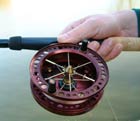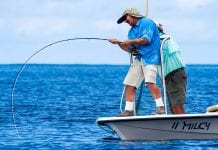| FIRST CLASS FISHING | |
Dave will cover a specific topic at a time in this bi-weekly column. The first section will be really basic with subsequent ones building on the skills covered previously. His aim is to explain things as simply and concisely as possible and will assume that the reader knows absolutely nothing about the subject. |
| FLOAT FISHING Part Seven – Stickfloat Fishing In parts one to six of Float Fishing I introduced you to the various types of waggler floats and showed you how to start fishing with them on both still and running water. In this part I will be introducing you to the classic river float, the stickfloat. The tackle
For general fishing the reel should be loaded with 2 to 3lb breaking strain line with a slightly lighter hooklength. Using maggots or casters as bait, hooks in sizes 16 through to 20 are what you need. What is a stickfloat?
Close quarter control The stickfloat is not designed to be cast very far, but where it scores really well is in swims where you don’t need to fish more than three rod lengths out and the water is of moderate, uneven pace and/or depth. With a stickfloat you can search these swims far more effectively than with a waggler, controlling the speed at which the float runs through and easily being able to change the depth you are fishing at simply by sliding the float up or down the line on the rubbers. They can also be shotted in a variety of patterns to present a bait in many different ways and by holding back the float and slowing it down you can make the bait rise and fall temptingly in the current. Float Choice If the pace of the water is quite fast you want the float to be as stable as possible and you should choose a float with as dense, and therefore heavy, as possible stem. Metal or lignum stemmed floats are ideal as they will naturally sit upright without any shot on the line. If the pace is not too fast and you are expecting bites off the bottom then a plastic stemmed float will give a good compromise presentation being quite stable, but sensitive enough to show on the drop bites reasonably clearly. Cane stems are the lightest and are particularly good for when fish are regularly taking your bait on the drop as they require the weight of the shot to make them sit upright. As each shot settles the float will gradually sit up and so give a good bite indication if a fish intercepts your bait on the way down through the water. The size of float depends on the depth of the swim. You should always choose as light a float as possible. As a rule of thumb choose a float that takes a no.4 shot for every foot of depth, ie, for a 4ft deep swim a 4 x no.4 float is the right choice, for a 6ft deep swim use a 6 x no.4 float. You may need to increase the size slightly in faster swims though to get the bait down quickly enough. Attaching your stickfloat Firstly, although you only need two bands to attach the float, one at the top and one at the bottom, it is a good idea to actually use three. By placing one in the middle as well gives you the assurance that you don’t have to break down your rig should one of the other two bands snap. You simply slide the third band into the position of the broken one. Another good idea is to use a long bottom rubber rather than a narrow band. By cutting a length of silicon tubing about When you purchase through links on our site, we may earn an affiliate commission, which supports our community.
|















